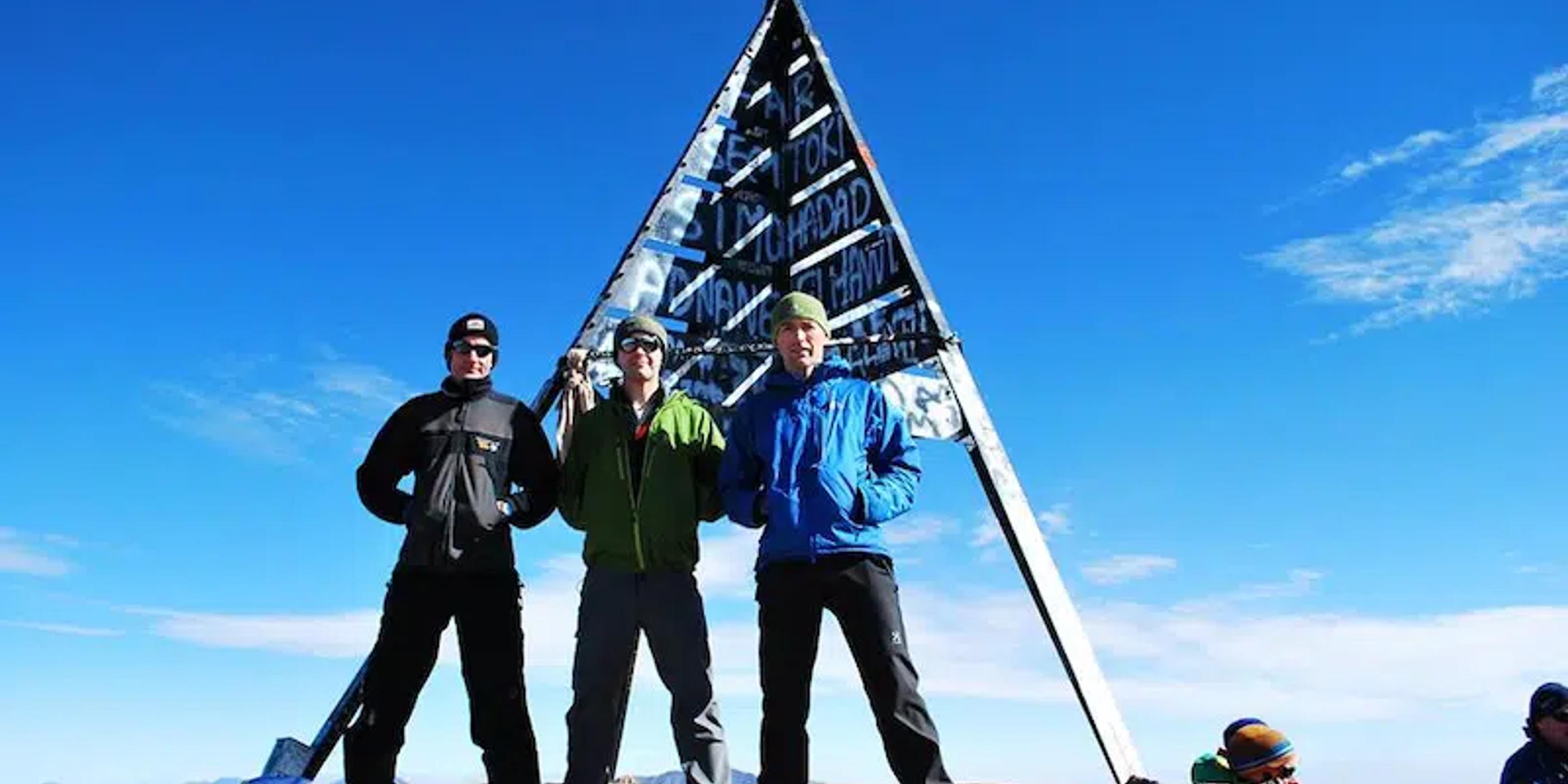
When's the Best Time to Climb Mount Toubkal?
So, when is the best time to climb Mount Toubkal?
It really depends on what you're looking for but in general, April to May and September to October are the best months for most people.
But if you want more of an adventure, Mount Toubkal Winter Trek can be perfect.
And summer is a good option for avoiding the crowds (but it's toasty!).
Local customs and events (e.g. Ramadan) can also impact your trekking experience.
This guide will explain the pros and cons of each season.
Let's dive in.
Fancy giving it a go?
Check out our Mount Toubkal Trek trip
(no experience needed, even for a Mount Toubkal Winter Trek)
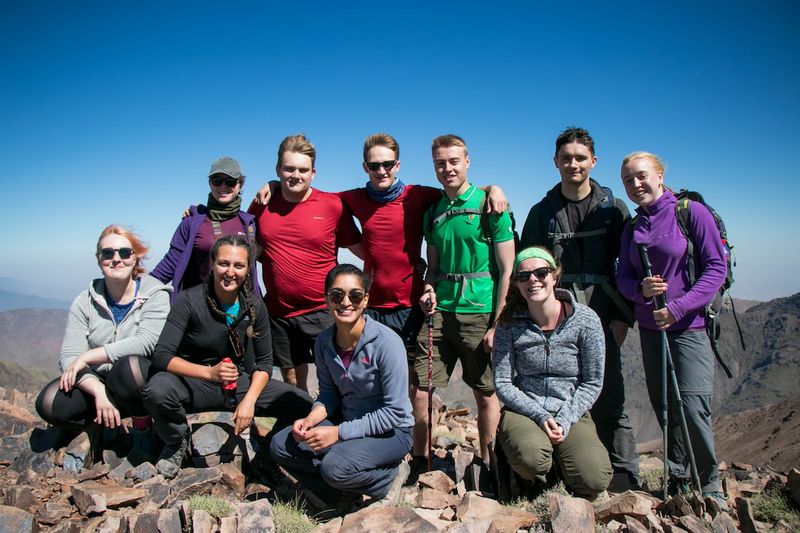
Best Months to Climb Mount Toubkal
The best months for most people to climb Mount Toubkal are April to May. September to October are also great.
These months have good, clear weather with mild temperatures and no sudden storms, making the trails easy to follow and the views from the summit of North Africa's highest mountain even more impressive.
See a summary of what to expect below:
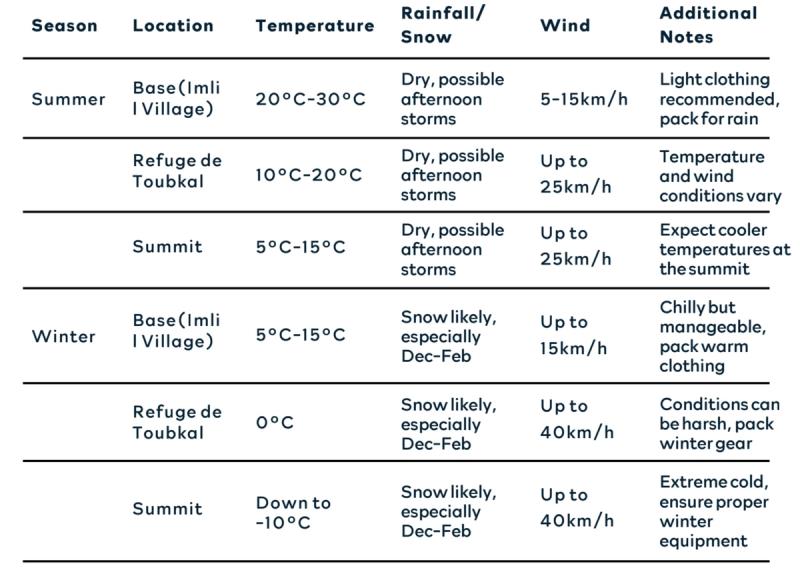
*note these are averages and the weather may be very different on any particular day
For more detailed packing tips and preparation advice, visit the full guide
Climb Mount Toubkal Tips From Local Expert [30 Years Experience]
But each season has its benefits and drawbacks, which we’ll get into next.
Spring (April-May)
Spring is a great time to hike the Mount Toubkal trek. Temperatures are moderate in April-May so you won't be exposed to extreme heat and the mountain will be quieter - it’s the best time to climb.
The trails are generally free of snow, apart from a few odd patches, so you won't have to worry about snow and ice.
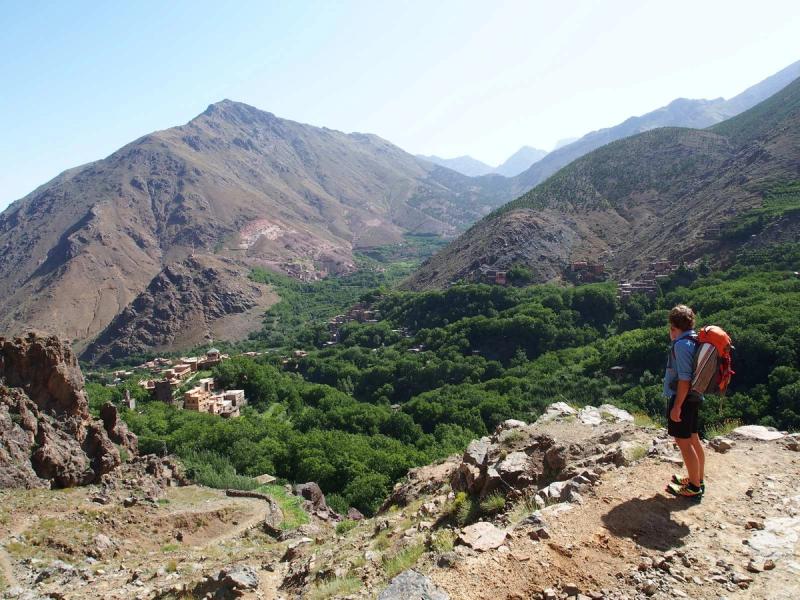
And the landscape is full of wildflowers, which make the usually barren mountains so much more colourful.
Imagine trekking through a wildflower-filled landscape under clear blue skies — yes, spring is a beautiful time for your Toubkal adventure.
Autumn (September-October)
Autumn is also a good time to climb Mount Toubkal. The weather is nice, but not too hot or too cold, making for comfortable climbing. The trails are less busy with fewer trekkers so you can enjoy crowd-free trails.
One of the best things about autumn is the foliage. The changing leaves make the already beautiful mountain scenery even more impressive.
With clear skies and mild temperatures, autumn is a good time for your Mount Toubkal adventure.
Climbing in Other Seasons
Mount Toubkal can be climbed all year round but summer and winter have their challenges. Summer is hot, Toubkal winter treks requires the use of an ice axe and crampons.
Knowing these challenges in advance will help you plan your trek so you’re prepared for what to expect.
Summer Heat (June-August)
Climbing Mount Toubkal in the summer can be more challenging because of the heat. Temperatures can reach 20°C to 30°C in the village of Imlil so dehydration can be more of an issue.
You must stay hydrated and take necessary precautions to avoid heat-related issues. Temperatures are cooler as you climb in altitude with the summit typically ranging from 5°C to 15°C.
Summer climbing is very doable but not everyone's cup of tea. The heat can make the trek uncomfortable for some and dehydration risk is always there.
If you do climb during summer start early in the morning to avoid the midday sun and make sure you have enough water and sun protection. Being prepared is crucial for a safe and enjoyable experience.
Winter Conditions (December-February)
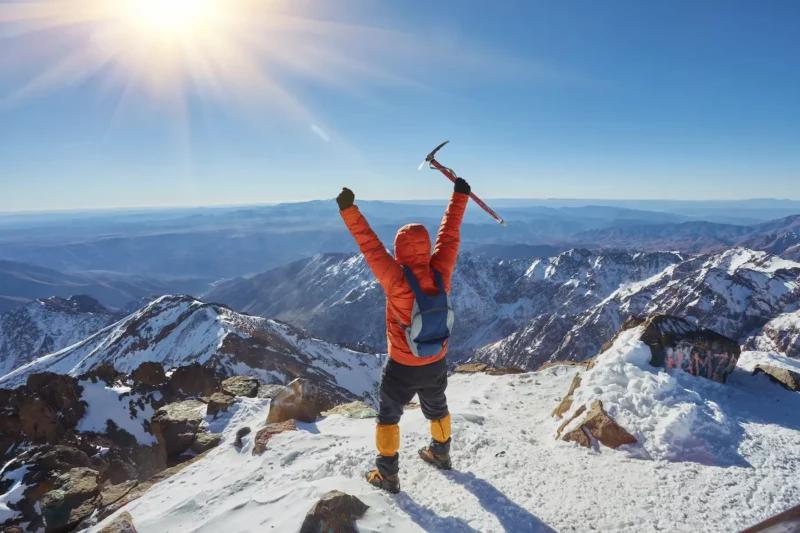
A Mount Toubkal Winter Trek is a whole different ball game, with its own set of challenges and rewards. Temperatures can drop to -10°C at the summit and the trails can be snow covered and icy.
For those who want more adventure a winter Mount Toubkal ascent can be very rewarding but you'll need to know how to use an ice axe and crampons.
Your guide will teach you how to use these and make a winter Mount Toubkal climb accessible, especially for those with limited/no experience.
Our Toubkal trips are guaranteed to run and depart almost every day of the year. You don't need any experience, even for winter ascents.
Take a peek if you fancy it Climb Mount Toubkal
Cultural and Seasonal Considerations
Climbing Mount Toubkal is not just a physical challenge; it’s also an opportunity to experience the local Berber culture.
Respecting local customs and traditions like asking before taking photos and using your right hand for eating is well advised.
Also, be mindful of seasonal events like Ramadan that can affect your trekking logistics and overall journey.
Climbing During Ramadan
If you climb Mount Toubkal during Ramadan you should respect the local customs around fasting. Fasting from dawn to sunset will affect the trekking pace and logistics as many local guides and porters will be fasting.
But trekking Toubkal during Ramadan is also a unique cultural experience, especially during the Iftar celebrations in the evenings.
Iftar after a day of trekking is an event to remember, it will give you a great insight into the local culture and traditions. Climbing around Ramadan requires some planning but the cultural enrichment is worth the effort.
Local Festivals and Events
Local festivals and events can affect your climbing experience. These events often coincide with trekking seasons, it’s a great opportunity to engage but also can be a challenge with more people on the trail and limited services.
Check the local festival calendar and dates for Ramadan before you plan your trip.
Packing for Different Seasons
Packing the right gear is crucial for a successful climb and the essentials vary depending on the season. From lightweight and breathable clothes for summer to technical gear for the winter months, having the right equipment will make your trek comfortable and safe.
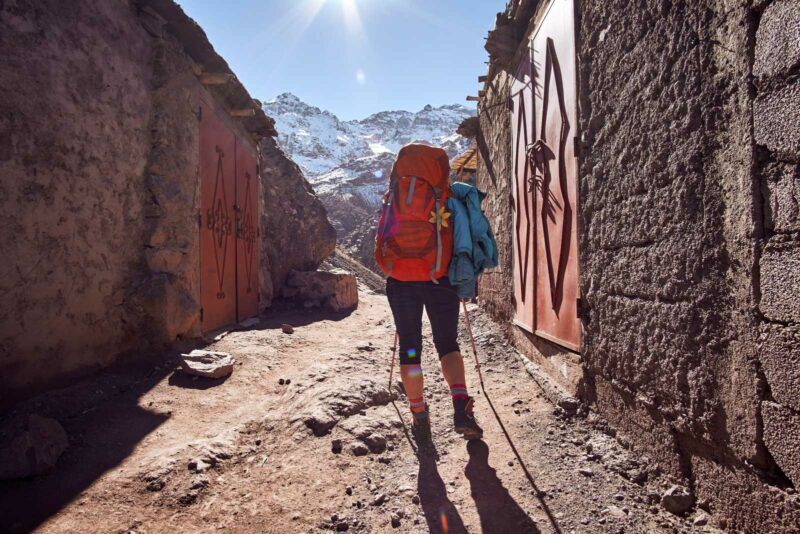
Spring and Autumn Gear
For spring and autumn climbs moisture-wicking layers are a must to keep you dry during the hike - a warm fleece and down jacket for insulation and a wind and waterproof shell for changing weather.
Good footwear is a must so invest in sturdy hiking boots with ankle support.
Accessories like a warm hat, scarf and waterproof gloves will be needed for summit day. Carry a 20-30 litre backpack for essentials and consider bringing a filtering water bottle to reduce plastic waste on the mountain.
Summer Gear
In the summer months staying hydrated is key. A hydration system like a 2-3 litre Camelback will ensure you have enough water throughout the trek.
Sunglasses with 100% UV protection for your eyes and lightweight and breathable clothes to keep you cool are also necessities.
Winter Gear
Winter climbs require more gear for the harsher winter conditions.
Bring technical gear like crampons and ice axes and an insulated down jacket for warmth - you get an ice axe and crampons included in the price if you climb Mount Toubkal with Call to Adventure.
You'll also need a hard shell waterproof jacket and waterproof gloves for wind and snow protection.
Preparation is key to a safe winter climb. Bring waterproof over trousers and a head torch for low light conditions. With the right gear and preparation, you can enjoy the epic adventure of a winter climb.
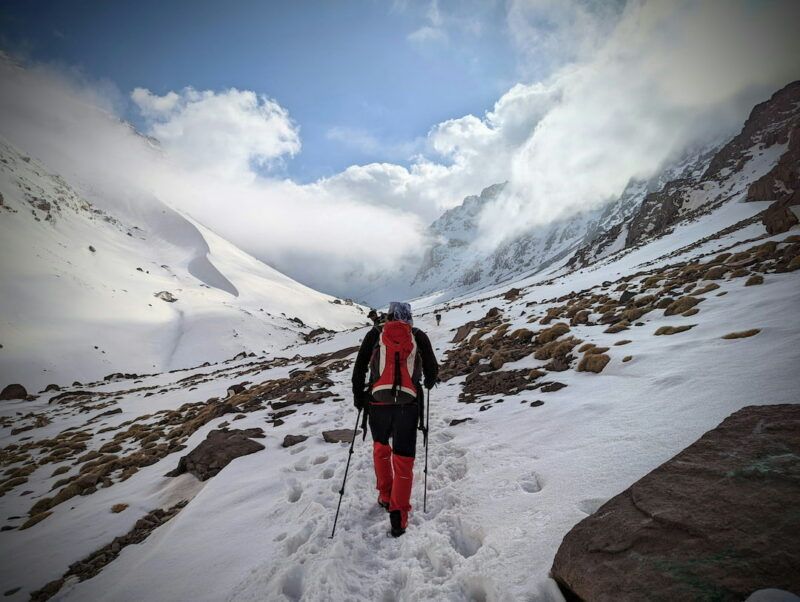
Typical Itinerary for Climbing Mount Toubkal
A typical itinerary for climbing Mount Toubkal is 4 days, structured but flexible, from Imlil to the summit and back. Each day is an experience and a challenge, this Mount Toubkal overview will give you an idea of the climb.
Day 1: Imlil
The journey starts with a 90-minute drive from Marrakech to Imlil, the main base for Mount Toubkal treks. Imlil has many outdoor shops and accommodation so it’s a great place to start.
Take time to acclimatise and prepare with a good night’s rest.
Day 2: Toubkal Refuge
On day 2 the trek to Toubkal Refuge starts.
The trek takes around 5 hours and passes through scenic areas like the village of Aroumd. The views and relatively gentle ascent in beautiful surroundings make this part of the trek very enjoyable.
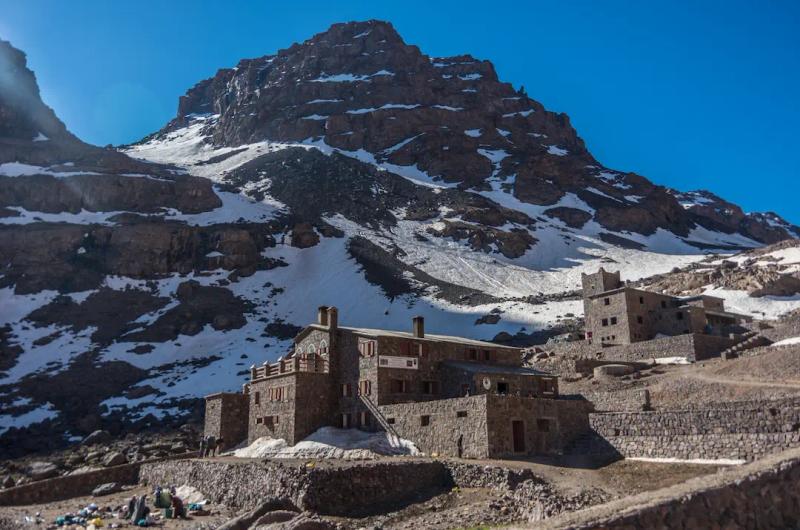
At the Toubkal Refuge climbers prepare for a summit attempt the next day. The mountain refuge is a chance to rest, recharge and acclimatise to the higher altitude so you are ready for what’s ahead.
Day 3: Summit Day
Summit day is the best part of the trek. The climb starts early and takes the South Side route to the top of Jebel Toubkal, the highest peak in North Africa.
The climb is straightforward but challenging due to the scree and altitude, it’s a test of endurance and willpower.
At 4,167m you’ll reach the summit and have panoramic views of the Marrakesh Plain and the High Atlas and Atlas mountains beyond.
After enjoying the moment and the views the descent back to Imlil starts and the trek is over - but hopefully with a huge sense of accomplishment.
Day 4: Transfer to Airport or City Centre
You have a transfer to the airport or another city centre location included in the price that you can take on day 4 or after if you prefer
Many people also choose to extend the trip. We can offer custom itineraries just for you.
Ready to give it a go? Check out our trip to Climb Mount Toubkal
Accommodation
When climbing Mount Toubkal you have two accommodation options: mountain refuges and camping. Each has its pros and cons and depends on your personal preferences, budget and requirements.
Refuges (Les Mouflons and CAF)
Mountain refuges like Les Mouflons and CAF are a communal experience where you’ll meet other climbers. Les Mouflons is more budget-friendly with large dorms and private room options and showers and a dining area.
CAF has better facilities, a kitchen and posher bathrooms so it’s a more comfortable but more expensive option.
If you want to know more, read our full guide Toubkal Refuge - What You Need To Know
Camping
Camping near Mount Toubkal is a more intimate experience with nature but requires more planning regarding equipment and weather. Camping is more private than the refuges but there are no bathrooms or cooking facilities.
We offer options to stay in the refuge or camp if you prefer.
Planning and being aware of the weather is key to a good camping experience.
Extend your trip
You can extend your Mount Toubkal experience by exploring Marrakech or adding a Sahara Desert trip to your itinerary.
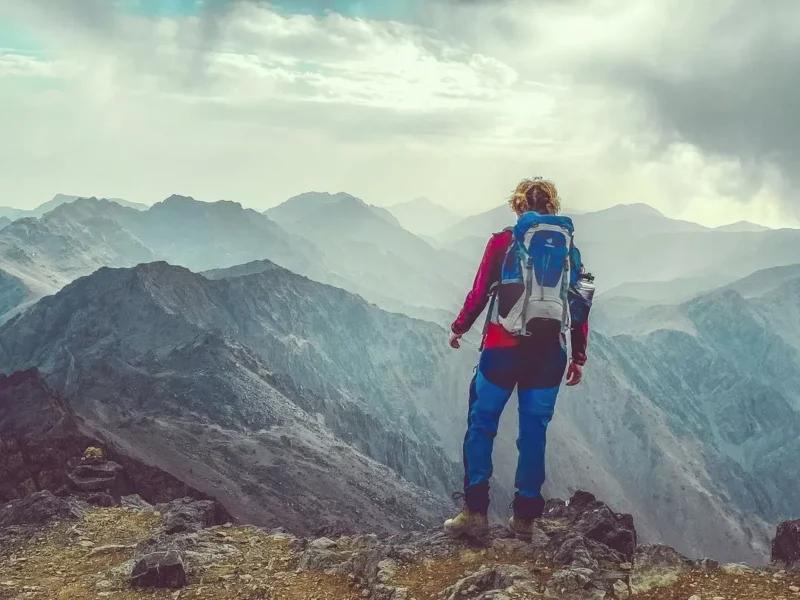
These extensions will give you a deeper insight into Morocco’s different landscapes and cultural heritage and make your adventure even more special.
Marrakech
After your climb, spend some time in Marrakech to experience the souks, historical sites and cultural experiences.
Don’t miss the Jardin Majorelle, a famous garden and museum with beautiful flora and a peaceful oasis in the middle of the city.
Sahara Desert Trips
A trip to the Sahara Desert is a world away from the mountainous Toubkal. Camel trekking, desert camps and hot air balloon rides give you the chance to see the desert’s vast landscapes, stunning scenery and starry skies.
Summing it all up
Climbing Jebel Toubkal is an adventure for (almost) everyone, from the High Atlas Mountains to the cultural experiences along the way.
The best time for most to climb Toubkal is April-May and September-October but each season has its pros and cons.
Proper planning, respect for local customs and the right gear is key to a successful climb. Whether you extend your trip with cultural trips or a desert adventure Mount Toubkal will be an experience you’ll never forget.
Want to find out more?
Check out our ultimate guide which covers everything you need to know
Climb Mount Toubkal Tips From Local Expert [30 Years Experience]
Best Time to Climb Mount Toubkal FAQ
When to climb Mount Toubkal?
The best time to climb is April-May and September-October when the weather is milder and the trails are easier. Plan your trip during these months for a more comfortable experience!
What gear do I need for a winter climb of Mount Toubkal?
You’ll need crampons, an ice axe, an insulated down jacket, waterproof gloves and a hard shell waterproof jacket for a winter climb of Mount Toubkal. Stay warm and safe!
Can I climb Mount Toubkal in winter if I’m a beginner?
Yes, beginners can climb Mount Toubkal in winter, especially with a guide to help you with the gear and techniques. Just be sure to bring the right clothing.
How does Ramadan affect climbing Mount Toubkal?
Climbing Mount Toubkal during Ramadan will slow down the trek as local guides and porters will be fasting but you’ll also get to experience the Iftar celebrations in the evenings which will add a special touch to your trip.
Where does the Mount Toubkal Climb actually take place?
Climbing Toubkal starts in the village of Imlil, located in the Atlas Mountains. It's usually then a 2 day hike up and down to actually climb Toubkal.
Jebel Toubkal is the highest peak in the Atlas Mountain Range and the highest peak in North Africa. Although there are plenty of other great peaks in the High Atlas Mountains.
What are the accommodation options on Mount Toubkal?
You can stay on Mount Toubkal in mountain refuges like Les Mouflons and CAF or camping but book in advance!
Ready to take the plunge?
Secure your space now Climb Mount Toubkal
Or for the winter version click here Mount Toubkal Winter Trek
About the Author

George Beesley
Adventure Lover & Founder of Call To Adventure
George just bloody loves a bit of adventure! Imagine someone who not only hikes up mountains for breakfast but also bikes across continents. Got a case of wanderlust? This guy's been to over 50 countries and comes back with stories that'll make your grandma want to go bungee jumping.

![Climb Mount Toubkal Tips From Local Expert [30 Years Experience]](https://cdn.sanity.io/images/f5ovd1ei/production/583602f19db9ccc67b832053ccba8ca25e090833-1660x1067.webp?w=80&h=80&fit=crop&auto=format)
